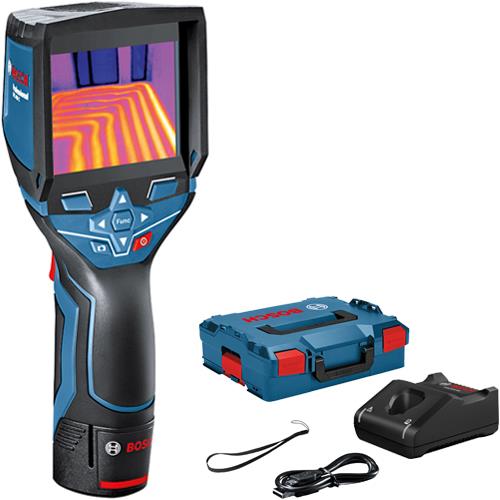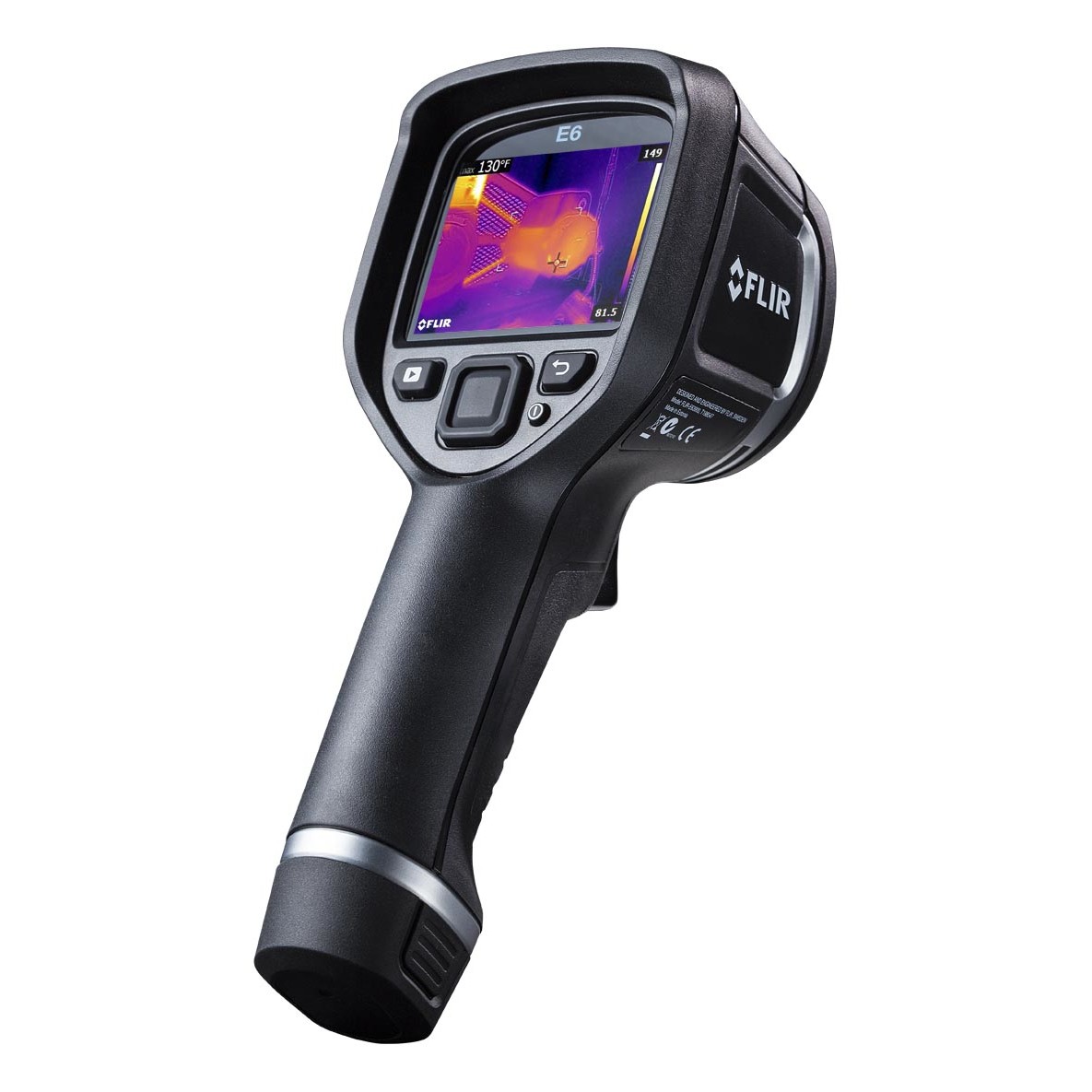PROS: IP53 waterproof, High Thermal sensitivity, Wide temperature range, flexible battery system, Wi-fi & Bluetooth
CONS: Internal memory can only hold 500 images.
| Product | Type | Resolution | Battery capacity | Waterproof | LCD screen | Price |
|---|---|---|---|---|---|---|
Bosch GTC 400 C  | Handheld | 160 x 120 | 12V Lithium-ion Battery or 4 AA batteries | Yes | 3.5″ | Click for more info |
FLIR E6 XT  | Handheld | 240 x 180 | 4 hours | Yes | 3″ (320 x 240 pixels) | Click for more info |
Bosch GTC 400 C Specifications
| Type | Handheld |
|---|---|
| Resolution | 160 x 120 |
| Pixels | 19200 pixels |
| Connectivity | MicroUSB, Wi-Fi |
| Temperature range | -104°F to 752°F (-40 °C to +400 °C) |
| Accuracy | +/- 3 ° C |
| Thermal sensitivity | 0.05°C |
| Distance | |
| Storage Type | Internal |
| Battery capacity | 12V Lithium-ion Battery or 4 AA batteries |
| Dimensions | 3.74 x 2.48 x 9.17 inches |
| LCD screen | 3.5″ |
| Refresh rate | |
| Applications | ideal for insulation, heater and radiator, windows, Roofing, Electrical Inspection, Automotive diagnostics |
| View Angle | 53° x 43° |
| Features | Waterproof, Dustproof, Manual Focus, Visual Camera |
Bosch GTC 400 C – Specs & Review
The Bosch GTC400C is Bosch’s first professional thermal camera. Because it is a 2017 model, it comes with micro USB and Wireless connectivity in the form of Wi-fi. The Wi-fi lets you wirelessly transfer the images to your Android or iOS smartphone, the micro USB is just for data transfer via USB cable (cannot be used for Charging) Let’s take our Bosch GTC400C review further and actually find out how it works.
To power it on, you just press the red power button and wait for about 5-10 seconds for the camera to fully start. If the protective cap is covering the lens, it will ask you to remove it. The protective cap is a good idea to keep the lens and the IR sensor free of dust, scratches and dirt.
On the screen, in terms of spot thermal measurement, the camera will display two dynamic spots which indicate the coldest spot and the warmest spot and along with those, the center spot which is fixed.
The infrared camera also allows you to change the detection mode. Normally it’s on automatic but you can set it to have a minimum and maximum temperature range, there is a cold detector and heat detector. These are pretty useful because they usually highlight the cold part or the warm part.
If you press and hold the function button, you’ll go into the settings menu. There you have quite a few options to fiddle around with. You can change the emissivity settings, even though most materials should work with the default 0.93 emissivity value, if you want to check body temperature at the forehead, it’s good to set it to 0.88 for a more accurate reading. Some materials also have a low emissivity like polished metals. You can also set the reflected temperature (which means the ambient temperature) to help the camera be more accurate.
The next part is display settings, where you can activate or deactivate the center spot measurement, hot spot or cold spot. Along with those, you get to choose your color palette. You can also quickly switch between palettes when you are capturing images, just press the left and right arrow buttons.
Other settings include turning on or off the Wi-fi and Bluetooth connection, changing the time, date, temperature units (Either Fahrenheit or Celsius) and Auto Power Off.
Bosch GTC 400 C – Thermal imaging quality
The IR resolution of the Bosch Professional GTC 400 C is 160 x 120 pixels which puts it exactly on par with the other infrared cameras in its price range with a total of 19,200 pixels.
Bosch hasn’t specified a refresh rate for the camera but it feels like it has a 8-9 Hz frame rate. They have not equipped this camera with a manual focus mode.
The camera is equipped with a visual camera as well as an infrared sensor and the two images are superimposed to create a more distinguishable picture. Now you need to be aware that this overlapping of the two images is at its most accurate when you are measuring from about 1.8 feet. There are 3 modes in which you can use the camera: IR mode in which you only see the thermal image, Picture-In-Picture in which you get the visual image with a cut out in the middle showing the thermal image and transparency mode where both images are intelligently overlapped.
Then there is the file format: the thermal images are saved in JPEG format and for every thermal image captured, the camera can also store a copy of just the visual image.
All the radiometric temperature data is stored in the image and you can later edit it using the GTC Transfer software. You can change the temperature range, color palette and many other aspects.
The minimum distance that the camera needs in order to focus is 0.3m from the measured object.
Bosch GTC 400 C – Temperature Range, Accuracy
The thermal sensitivity of the device is very good, with a value of 0.05° C. We were quite impressed with this value because other thermal imaging devices generally offer a thermal sensitivity of 0.10° C.
The temperature range that it can measure comes between -40° C and 400° C and here it does very well because you can use it all year round, you can inspect refrigeration devices, freezers and check for insulation problems in the cold winter. But at the other end, HVAC inspections will be a breeze because you can troubleshoot problems with heaters, check insulation on ovens and stoves.
The accuracy is something that can be improved as Bosch states that it only has a +/-3° C accuracy. Normally if you pay this much for a camera you should expect to get a temperature measurement accuracy of about +/-2.
The viewing angle is wide enough for most applications with a field of view of 53° by 43°.
Bosch GTC 400 C – Battery life & Memory
With regards to internal memory, this thermal imager doesn’t have an SD Card slot, just an internal memory with a capacity of just 500 images.
But if the storage is very limited, the battery system is quite flexible. You can power this thermal camera with either the 12 V LI-ION battery or by using 4 AA batteries. In the package along with the camera, you get a 2000mah battery pack, a quick charger which is like a stand for the camera and this cool L-BOXX from Bosch to store the camera which looks more professional than any other thermal camera box we’ve looked at.
The Bosch GTC 400 C has an IP53 rating which means it is completely dustproof and waterproof to an extent. It can take rain and light splashes.
What we like is the large color screen because this infrared thermal scanner is equipped with a large bright 3.5″ LCD screen. The camera doesn’t weigh much, just 0.54kg so it is quite compact and lightweight.
Bosch offers a 3-year warranty on many of their tools, but for this one we couldn’t find an official document stating the warranty period and on Amazon, a warranty period is not specified either.
We don’t know exactly how the situation is with a firmware update as there is no option for that in the GTC Transfer software nor a place where you can download a new version of the firmware. Even after looking through the user manual we couldn’t find anything.
